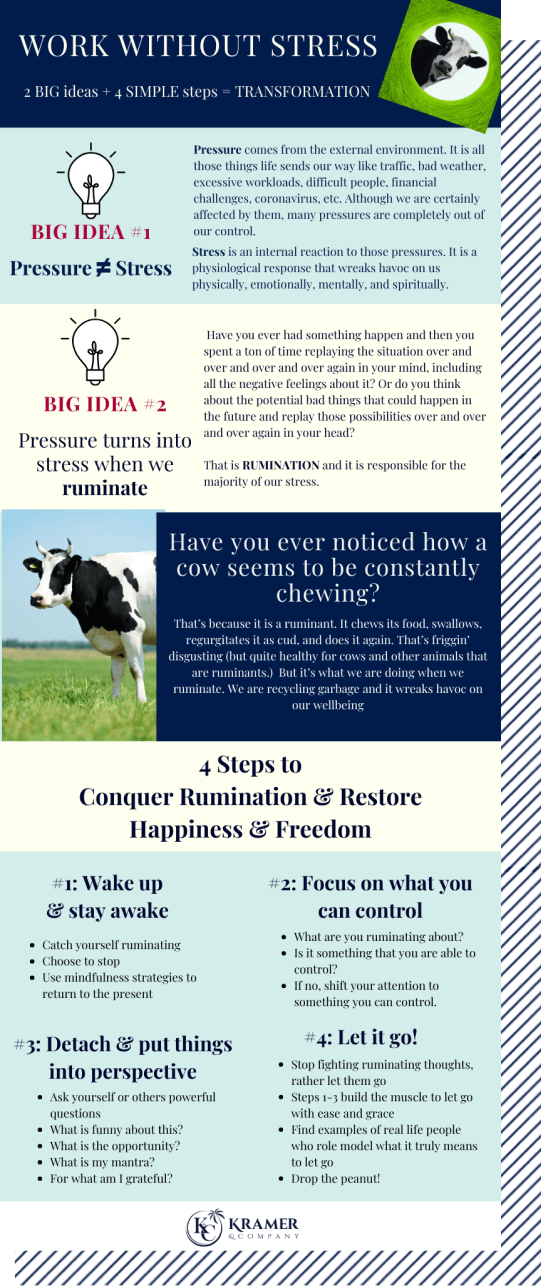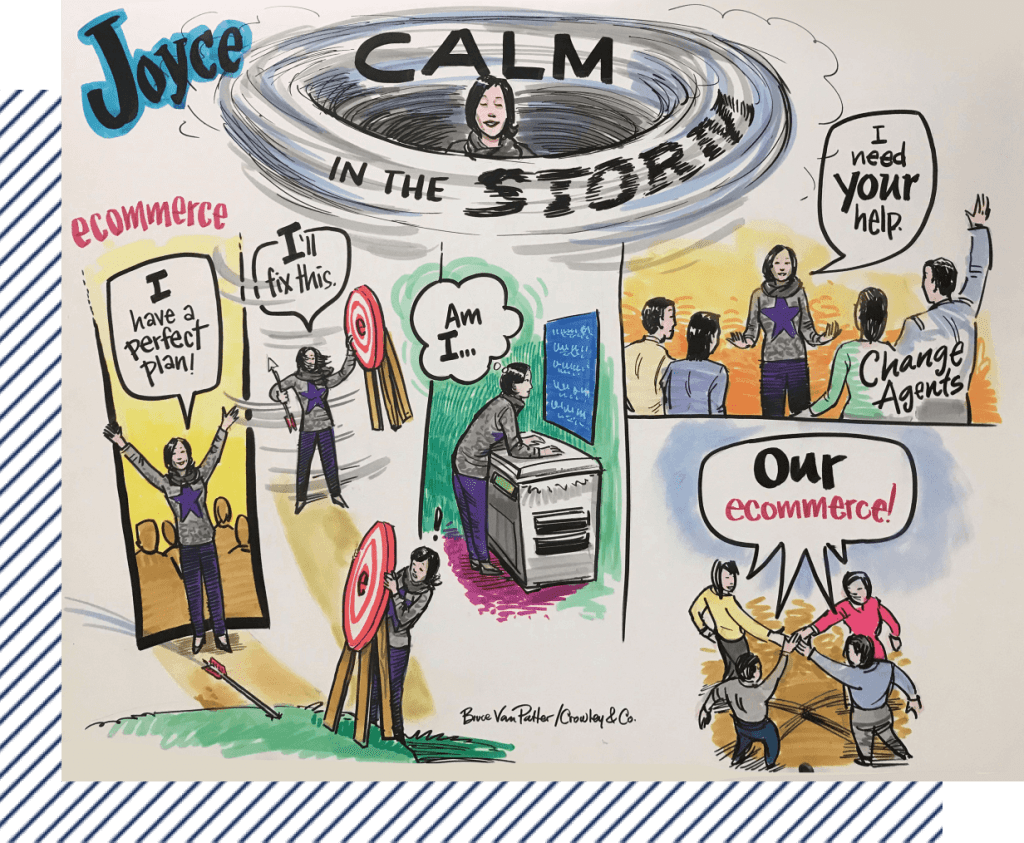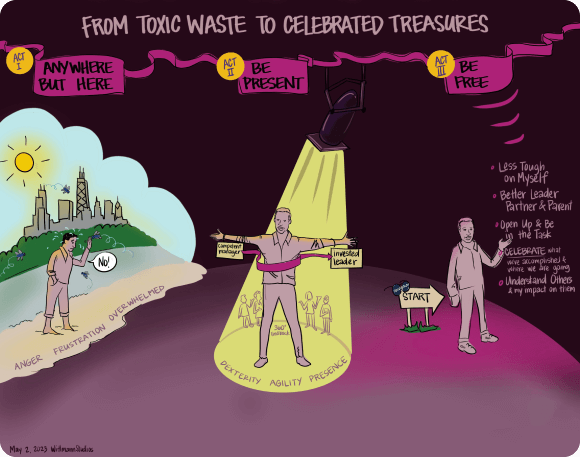Signature Programs
Work Without Stress
“People tend to think that coping is managing to keep your head above water. Resilient people are presumably those who can hold their breath longer when the flood rises, but this is just surviving. Real resilience is knowing there’s no water to keep your head above.” ~ Dr. Derek Roger
Why is it given the exact same event, two people can react completely different?
rumination.
30 years of research shows that 80% of our everyday stress can be explained by this prevalent and habitual process few of us even realize we are doing- – -rumination.


In this half-day, interactive workshop I share my personal stress story. After experiencing two stress-induced, life-altering physical disorders, I discovered the Work Without Stress program.
I diligently applied the tools to myself and experienced tremendous results. Not only did I get control over those two conditions, but I also lost 70 pounds, reduced my blood pressure to double digits, and rarely, almost never, get sick. (Not to mention, I am full of ridiculous amounts of joy, freedom, success, and peace.)
In this half-day interactive workshop, participants will:
- Discuss why most stress management programs don’t work
- Identify how stress affects them physically, emotionally, mentally, and socially
- Discover the rumination response and experience what it feels like when its happening
- Examine their own propensity for rumination
- Learn and practice four steps for conquering rumination
- Complete the Challenge of Change assessment to assess their current mindsets and behaviors that are contributing to (or preventing) stress
For participants who lead people, the program extends to six hours and includes strategies for applying the four steps to teams and a working session to build a culture of emotional and mental resilience.
Storytelling for Leaders
Stories constitute the single most powerful weapon in a leader’s arsenal.~ Dr. Howard Gardner, Harvard
Great leaders understand the importance of telling compelling stories. Stories create connection. They build trust and foster cooperation and collaboration. Stories allow us to have an authentic relationship with others. They allow an audience to get to know the leader (or business or product) on a personal and more human level. They also make an idea come alive so that the audience is more engaged and personally invested. A great story told in a great way can make the difference in landing new business, selling an idea to a stakeholder, increasing influence, getting promoted, or winning over a tough customer. And…storytelling can be loads of fun!

Storytelling is both an art and a science.
Its effectiveness as a compelling leadership competency is backed by neuroscience and brain research. A well-told story activates seven different parts of the brain. (A PowerPoint presentation hits only two, provided the audience stays awake.) This means the audience understands more, remembers more, and is more personally invested. Furthermore, a feel-good story can release oxytocin in our bodies, causing us to feel more connected and cooperative with the storyteller. Our Storytelling Programs range from a half-day workshop to two day events that often culminate in a Storytelling Expo for members of your organization to attend. We also partner with a community of graphic illustrators who help participants tell their story with images and metaphors.
Participants in Storytelling for Leaders programs:
- Learn and practice the art and science of storytelling
- Discuss why storytelling is a critical part of their leadership and business
- Learn the components of a great story
- Apply their learning to craft a personal story of their own
- Collaborate with their peers to practice and revise their story
- Explore their storytelling presence
- Practice telling their story in an authentic and compelling way
- Leave with at least one ready-to-tell story they can immediately use

Capacity for Complexity:
Vertical Development for Leading in a VUCA World
Leadership programs focus on two types of development: Horizontal (capability) and Vertical (capacity.)
Horizontal Development is teaching leaders new skills, addressing competencies, increasing knowledge, and adding tools to their proverbial toolbox. This is the type of development most leadership initiatives spend their time. As leaders take on additional responsibility and rise in their organization, the demands of their roles increase dramatically. Complexity, ambiguity, diversity in stakeholders, scope of influence, competing tensions, time pressure, magnitude of decisions…everything increases. This reality requires both skill and capacity.
Vertical Development is growing a leader’s capacity to think and behave in more complex, strategic, systemic, sustainable, and interdependent ways.
Growing Vertically doesn’t happen as the result of a one-day event. It requires intentional and sustained effort. The first step is awareness and the desire to take on this kind of development. From there, a variety of ongoing strategies and practices are used to accelerate the leader’s vertical development. These take many forms and fall under four overarching categories: Heat Experiences, Colliding Perspectives, Reflection, and Activation.
We organically build Vertical Development into all of our programs. In the last few years, we have had clients asking for a standalone program solely focused on vertical growth. And so we created the Capacity for Complexity program. In this class, participants:
- Differentiate vertical growth from horizontal growth
- Explore their own development journey
- Link the need for higher-order thinking to the achievement of strategic goals
- Examine the different stages of vertical development, including the upsides and downsides of each
- Experience the different stages in action through a complex and fun experiential activity; dissect the activity to discover different ways of thinking and acting that exemplify each stage
- Identify their current vertical development stage and how it is benefitting and hindering their leadership effectiveness
- Examine their behavior during times of stress and how to use vertical development strategies to remain effective and productive during times of pressure
- Create a plan for their development, as well as the growth of their team

